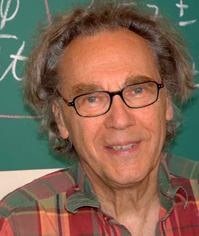This is an old revision of this page, as edited by Rglovejoy (talk | contribs) at 17:31, 19 December 2007 (Added attribution for NYT article). The present address (URL) is a permanent link to this revision, which may differ significantly from the current revision.
Revision as of 17:31, 19 December 2007 by Rglovejoy (talk | contribs) (Added attribution for NYT article)(diff) ← Previous revision | Latest revision (diff) | Newer revision → (diff)| Walter H.G. Lewin | |
|---|---|
 A recent photo of Professor Lewin. A recent photo of Professor Lewin. | |
| Born | 1936 The Netherlands |
| Nationality | |
| Alma mater | Delft University of Technology |
| Awards | NASA Award for Exceptional Scientific Achievement (1978) Alexander von Humboldt Award (1984 and 1991) Guggenheim Fellowship (1984) MIT Science Council Prize for Excellence in Undergraduate Teaching (1984), W. Buechner Teaching Prize (1988) Evertt Moore Baker Memorial Award for Excellence in Undergraduate Teaching (2003) |
| Scientific career | |
| Fields | Astrophysics |
| Institutions | MIT |
Walter H. G. Lewin is currently a professor of Physics at the Massachusetts Institute of Technology. He earned his Ph.D. in Nuclear Physics in 1965 at the Delft University of Technology in the Netherlands.
Walter Lewin came to MIT in January 1966 with the intent of spending one year in a post-doctoral position, but he never left. He joined an x-ray astronomy group at MIT and conducted all-sky balloon surveys with George W. Clark. Through the late seventies, there were about twenty successful balloon flights. These balloon surveys led to the discovery of five new x-ray sources, which doubled the number known at the time. Furthermore, some of these x-ray sources were found to be varying, and some were x-ray flares. The rockets used by other researchers could not have discovered that the x-ray sources varied because they were only in the air for a few minutes, whereas the balloons could be in the air for many hours. The surveys also resulted in the discovery of GX 1+4, which was the first slowly rotating X-ray pulsar found.
Walter Lewin received the "2003 Everett Moore Baker Memorial Award for Excellence in Undergraduate Teaching" award. Some of his lectures are available online in video format.
Lewin usually wears a button down shirt to class, and almost always has an eclectic pin on his shirt (ranging from an egg to a banana to a smiley face).
Lectures
The Walter Lewin Lectures on Physics at MIT are legendary. Many have been shown for over six years on UWTV in Seattle, reaching an audience of about four million people. He personally responded to all e-mail requests he received (hundreds per year) from UWTV viewers, who varied in age from 7 to 90. For fifteen years he was on MIT Cable TV helping freshmen with their weekly homework assignments. His programs, which were aired 24 hours per day, were also frequently watched by upper-class students. Lewin is the soul of PIVoT, a video course on Newtonian Mechanics with a total of 53 hours of video clips. Additionally, his 36 lectures on Electricity and Magnetism and 23 lectures on Vibrations and Waves can also be viewed from the course's web site. Finally, his special lectures given at MIT for science teachers and for middle school students can be viewed on MIT World.
Selected publications
- Lewin, Walter H.G. (204-10-27). "X-ray Bursts". Space Science Reviews. 62 (3–4): 223–389. doi:10.1007/BF00196124.
{{cite journal}}: Check date values in:|date=(help); Unknown parameter|coauthors=ignored (|author=suggested) (help)
- D. Pooley, W.H.G. Lewin, S.F. Anderson, H. Baumgardt, A.V. Filippenko, B.M. Gaensler, L. Homer, P. Hut, V.M. Kaspi, B. Margon, S. McMillan, S. Portegies Zwart, M. van der Klis, & F. Verbunt (2003). "Dynamical Formation of Close Binary Systems in Globular Clusters". Astrophysical Journal. 591: L131 – L134. doi:10.1086/377074.
{{cite journal}}: CS1 maint: multiple names: authors list (link)
- J. Miller, A. Fabian, R. Wijnands, R. Remillard, P. Wojdowski, N. Schulz, T. Di Matteo, H. Marshall, C. Canizares, & W. Lewin (2002). "Resolving the Composite Fe K-alpha Emission Line in the Galactic Black Hole Cygnus X-1 with Chandra". Astrophysical Journal. 578: 348–356. doi:10.1086/342466.
{{cite journal}}: CS1 maint: multiple names: authors list (link)
- D. Pooley, W. Lewin, L. Homer, S. Anderson, B. Gaensler, B. Margon, F. Verbunt, J. Miller, D. Fox, V. Kaspi & M. v.d. Klis (2002). "Optical Identifications of Multiple Faint X-ray Sources in the Globular Cluster NGC~6752: Evidence for Numerous Cataclysmic Variables". Astrophysical Journal. 569: 405.
{{cite journal}}: CS1 maint: multiple names: authors list (link)
- C. Kouveliotou, J. van Paradijs, G. J. Fishman, M. S. Briggs, J. Kommers, B. A. Harmon, C. A. Meegan, W. H. G. Lewin (1996). "Discovery of a New Type of Burster from the Galactic Center Region". Nature. 379: 799.
{{cite journal}}: CS1 maint: multiple names: authors list (link)
- M. v.d. Klis, J. Swank, W. Zhang, K. Jahoda, E. Morgan, W. Lewin, B. Vaughan, & J. van Paradijs (1996). "Discovery of Sub millisecond Quasi-periodic Oscillations in the X-ray Flux of Scorpius X-1". Astrophysical Journal. 469.
{{cite journal}}: CS1 maint: multiple names: authors list (link)
- W.H.G. Lewin, G.W. Clark and W.B. Smith (1968). "Observation of an X-Ray Flare from Sco X-1". Astrophysical Journal (Letters). 152: L55.
See also
External links
- Walter Lewin's page at MIT
- MIT Physics Department website
- Walter Lewin's Physics I Course Page with Video Lectures
- Walter Lewin's Physics II Course Page with Video Lectures
- Walter Lewin's Physics III Course Page with Video Lectures
- The Elegant Universe PBS Video featuring Walter Lewin
- Rimer, Sara (2007-12-19). "At 71, Physics Professor Is a Web Star". The New York Times. Retrieved 2007-12-19.